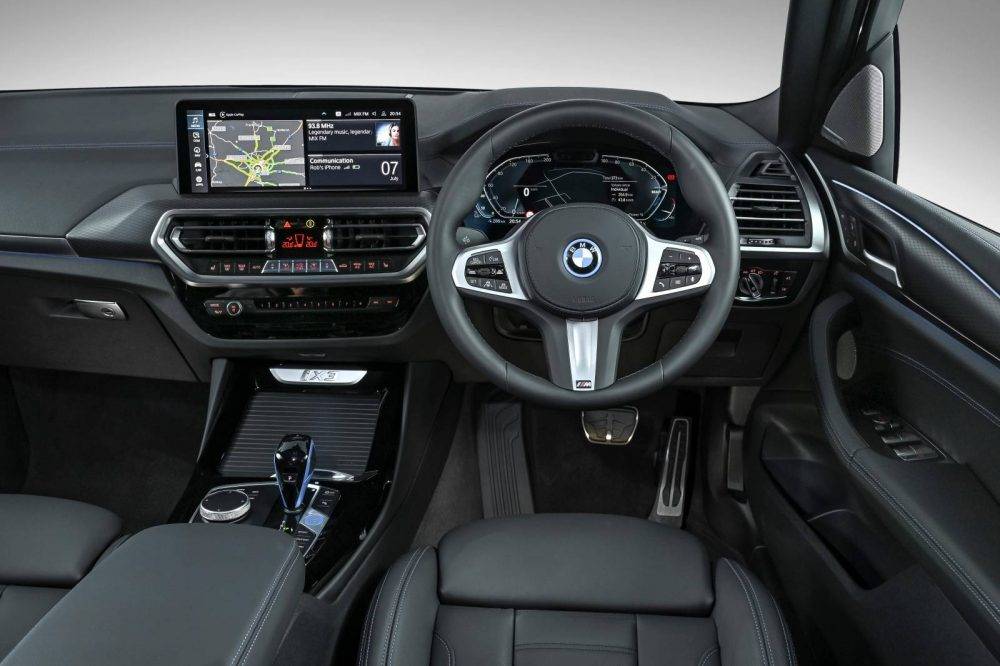Into the future: There’s little on the exterior to tell you that the new BMW iX3 is electric. (Deon van der Walt)
From in-line-six aeroplane engines, notably the “IIIa”, to motorcycles that redefined two-wheel aerodynamics, BMW’s history is one of stark contrasts.
Add to that what it’s best known for — silicone-and-metal boxes with four wheels — and those chummy with business parlance might say it’s adept at pivoting sellable ideas.
But, arguably, its biggest pivot since the marque’s inception in 1916 has been selling the public the idea of electric vehicles (EV).
When it introduced the i3 in 2013, it was the butt of many jokes — “Duracell-hogger”… you get the idea. A decade later, though, it has made considerable strides in the field of EVs — think i7, iX and the subject of this review, the iX3. Spoiler alert —this is not a garden-variety X3.
I absolutely don’t blame you for thinking it is. The only tell-tale signs of this medium-sized SUV’s electric disposition are the blue-accented badges, the air-slicing 20-inch wheels and the largely functionless flat cover that blacks out the area traditionally reserved for kidney grilles.
Even inside it’s not the sci-fi convention you’d expect. You could argue it’s an unimaginative space and missed opportunity, as I have with several of BMW’s internal combustion engine cars using dated architecture. Still, in this instance, I think it’s pretty brilliant.
Isn’t using a model that’s familiar and exceedingly popular the way to go about easing the traditionalist buying public into buying electric cars? As opposed to a vehicle with more informational readouts than a nuclear submarine? I think so. You’re not catapulted into the future but rather eased into it.
Inside, some good ol’ dedicated buttons (within the dated dashboard design) still perform their functions seamlessly. Want to change the volume of your favourite Ed Ginger song? There’s a rotary button and traditional buttons on the steering wheel for just that. No fingerprint-smeared touch-sensitive sliders.
The seamless infotainment screen and digital instrument cluster, both measuring 12.3 inches, are the biggest giveaways of the electric nature of the iX3.
On the infotainment screen, you get all the usual media and navigation interfaces, with the addition of being able to select a default charging target — think of it as going to the filling station and asking for R500 petrol.
 Dial up: The BMW iX3’s interior has many regular features and is not the futuristic cabin some might expect.
Dial up: The BMW iX3’s interior has many regular features and is not the futuristic cabin some might expect.
On the instrument binnacle, you still get your speed and the option to overlay media and navigation in the centre readout.
On the right, instead of a traditional tachometer, you get an energy readout in 20kWh increments with a battery regeneration interface.
The regen meter connects to another unique-to-electric Beemers feature, the “B” located on the left of the drive selector. Slot it in, and the car prioritises kinetic energy recovery through the brakes which would otherwise be lost to the atmosphere.
It’s a feature that’s initially imposing since even slightly lifting off the throttle sends the iX3 into an automatic state of braking and energy recovery. After a day, though, I’d learned to adapt my driving to the point where I would find myself not braking once over a 30km journey, so, yes, it becomes easy to live with.
No BMW would be complete without a signature sporty element. The iX3 has three driving modes: Eco Pro, which does what it says on the label, ditto with Comfort and, naturally, there has to be a Sport mode. Press that button, and the instrument screen turns an angry red. That’s pretty much it. No artificial exhaust sounds, which I appreciated, and no touchy-feely I’ll-kill-you throttle responses.
The minuscule changes in character I did feel I’m pretty sure can be chalked up to the power of suggestion. Here’s my suggestion to BMW — remove all modes, standardise Comfort and shave R100k off the sticker price.
It doesn’t need “Sport” because this battery-mobile bolts like lighting. It’s rated at 210kW and 400Nm of torque, translating to a 0 to 100km/h time of 6.8 seconds. So, it’s quicker than most middle-of-the-road hot hatchbacks.
But it’s not the velocity that gets you as much as the jump off the line, with instantaneous torque thanks to minimal moving components. Add to that the silent whoosh of wind rushing past and it’s like a fever dream of soaring with a wingsuit.
To the business of living with the iX3, then? Well, it’s easy. Sure, I had to contend with sporadic load-shedding, but with some careful planning, the GridCars DC fast chargers at shopping malls made for a recharge in less than two hours thanks to steady 41kW recharging of the 80kWh battery. BMW says it can support up to 150kW recharging.
As for the range, after a full recharge, the iX3 states it can go 350km, but with thoughtful driving on mostly city roads, I reckon that is seriously understated.
Would I buy one? If I had R1 306 400 to part with, and a semi-off-grid setup at home, I’d take the plunge in a heartbeat. I adore everything about the iX3 — its familiarity and how far BMW’s EV programme has come. Oh, and that stealth performance capability …
It’s a hefty price, though, what with the duty taxes imposed on the iX3 but, ultimately, that is not a commentary on what BMW has achieved since it has indeed pivoted with a view to the future.
So, with that, I give the iX a solid 9 out of 10. I still believe the interior layout should have been retired aeons ago and, well, it’s a matter of principle. And I will surely miss the noisy, soot-and-petrol-spitting conventional engines.